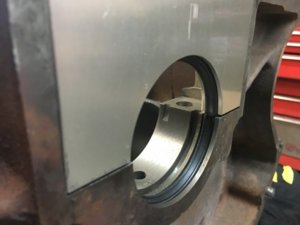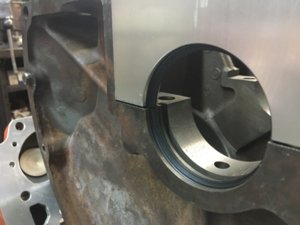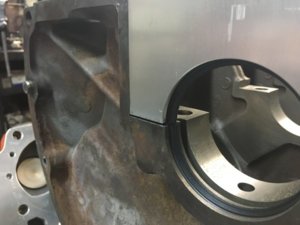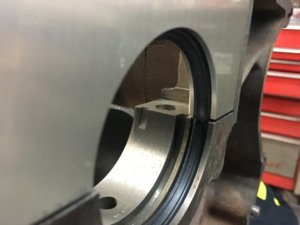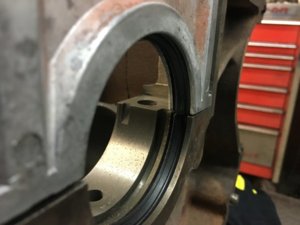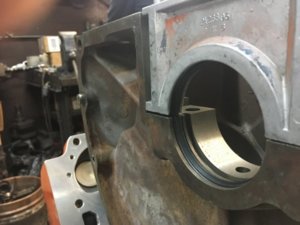OK, just an
update... I'm new at all this, so I guess my comments will be directed more at those who might be apprehensive about this job, as
I definitely was!! Another FFBO member & I replaced my 383 main seal with the engine in the car & the car on his lift (Texas MOPAR owners ROCK!) ....& yes, you could do this with the car on jack-stands or ramps... just adds a level of difficulty like any other job without a lift. But it wouldn't be "horrible". My engine is now
completely DRY underneath.
Not a single drop on the garage floor! But, it took some doing & I'll add those "pointers" here. Really, this is probably just a confirmation of info in the posts above that was "spot on" & helpful.
First, perhaps I'm the luckiest guy in the world, but we got it with *one* try & we used NO "alignment prying" nor measuring on the seal retainer. Really, none of that was/is an option with the engine in the car... it's too far up in there & no room. In fact, the retainer went in (slides upwards)
very tightly... so if Chrysler had machined any misalignment on the retainer to the crank bore, we could
not have seen it or done anything about it. I'm not saying that the "mis-alignment" phenomenon isn't real... maybe just not as prevalent as some of the above posts indicate? (or maybe I
am the luckiest guy in the world). I wouldn't let all the info above (or on those other forums) deter you from the job ... it's SO nice to have an oil-free garage floor!!!
I used the Viton seal from Hughes Engines, "BB REAR MAIN SEAL - PREMIUM, Part # *FEL 2947", along with the "BB REAR MAIN SIDE SEAL, Part # *USS CS4240SB" (both seem to be the same that is offered at 440 Source, see the link by khryslerkid in post #2).
Reference Post #13 .... as I've mentioned, with the engine in the car, we couldn't do any of that measuring & math suggested there, but the last page of those instructions is important! The side seals are the correct length. It's a very tight fit sliding it all into place, even after putting oil on the side seals (but you definitely want to put some oil on the side seals). Someone had posted somewhere that just a touch of super glue in each end of the two grooves will help to hold the side seals in place. I did this after one failed attempt to slide the retainer into place without the side seals sliding part way out. That was a GREAT tip! I don't know if I would have gotten it all in correctly without the touch of super glue.... you're sliding the retainer up into a tight space with two wiggly side seals oiled up ... juggling three pieces with oily hands. The setup is so tight, that you also run the risk of damaging the side seals (on the machined "flat" on the block) as the retainer is forced up into place ... a
spare set of side seals in hand might be comforting at this point in the job! But, yes, if the side seals end up not *flush* with the block once the retainer is installed, then they're not in all the way (mine were maybe protruding a millimeter or less, which they were when "on the bench" out of the engine). If there's "extra" to trim once installed, don't trim it off! Do it over (perhaps with your spare set?).
Main seal itself: I staggered it maybe 1/8" as illustrated & discussed in all the instructions, ...with just a tiny smear of Permatex #51813 (don't know why I bought the 50ml tube... Permatex 518
17 is the same thing in a 6ml tube). I used Permatex because I couldn't find the recommended Locktite 518 ... it's all the same stuff "
518". I think the key here is that you want to be using a *
anaerobic* gasket maker. And this tiny smear on the little ends of the main seal is just to sort of "glue the circle together". I only did this on the two ends in the retainer cap. Can't really do that to the ends of the seal that you've already slid up & around the upper side of the crankshaft.
Those instructions referenced above suggest a thin smear of silicone sealer on the [metal] retainer ends before sliding it into place.
Thin is the key!! On the metal retainer... not on the seal ends where you put the 518 stuff.
Along the lines of "less is more",.... in the days after completing the job, I was convinced that my seal was still leaking, since I always had a small oil drop at the weep hole on the bottom of the flywheel dust cover. But then I noticed that the oil pan gasket had oozed out at one corner. I didn't think that was leaking, but I decided to replace the oil pan gaskets again, just to make it right. When I pulled the oil pan off, I could see up in front of the flywheel at the crankshaft, and it was perfectly dry! So I knew the new seal wasn't leaking! So, "on" with the new oil pan gaskets, & I have NO leaks anywhere now! (it's funny how an oil leak from the pan must swirl around under the car when driving & end up on that weep hole back on the flywheel dust cover... makes it look like a rear seal problem!) Lesson learned.... with two pan gaskets being used (pan -
gasket - windage tray -
gasket - engine block),
like a big peanut-butter sandwich... too much RTV sealer is gonna make one of those gaskets ooze out & tear! (That's what mine did.) I think you want to use
just enough RTV on both sides of each gasket, to address any pitting or uneveness on the pan & windage tray surfaces. That's it. A fairly thin smear. Using RTV like butter (as I did the first time) will mean you're going to repeat the job (& a pan leak will look like a rear seal leak which is quite the "let down" after all this work).
I know I'm addressing some real "basics" here, but if you've never done the job before, like me, perhaps this will be helpful.
BTW, I used the "MP-15" oil pan gaskets from Hughes (part # SFP 2585) .... two sets are needed (assuming you have a windage tray in your pan).
One more thing. The rear seal needs to be installed facing the correct way. I had read this & known this. "No brainer" I thought. But, once it was all apart, I started to "second guess" myself on *which way* was correct (don't want to make a mistake at this point). In post #13 above, photos # 7, 8, 9 (unlabeled) ... the way the retainer & seal is orientated in those photos, your're looking at the back of the engine (looking forward toward the crankshaft). The pronounced
seal lip is nearest the crankshaft. (Seems obvious, but one could make the argument that maybe the "stepped" part of the seal should face the crankshaft, with the lip at the aft end ....
forget that I said that!!!!)
I'm going to go have dinner on my garage floor now (it's so clean

)
Thanks also for all who contributed on this thread!!! FBBO ROCKS too !!!
